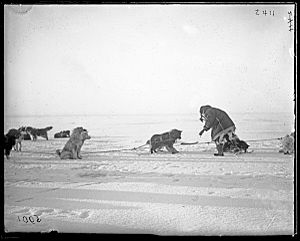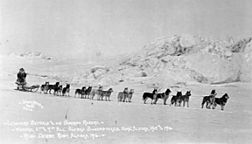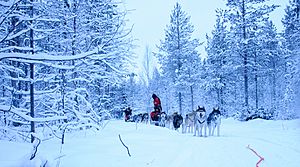Siberian Husky facts for kids
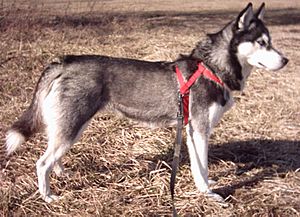
Black and white Siberian Husky
|
|||||||||||||||||||||||||||||||||
| Other names | Chukcha | ||||||||||||||||||||||||||||||||
|---|---|---|---|---|---|---|---|---|---|---|---|---|---|---|---|---|---|---|---|---|---|---|---|---|---|---|---|---|---|---|---|---|---|
| Common nicknames | Husky Sibe |
||||||||||||||||||||||||||||||||
| Origin | Siberia | ||||||||||||||||||||||||||||||||
|
|||||||||||||||||||||||||||||||||
|
|||||||||||||||||||||||||||||||||
| Domestic dog (Canis lupus familiaris) | |||||||||||||||||||||||||||||||||
The Siberian Husky is a medium-sized working sled dog breed. The breed belongs to the Spitz genetic family. It is recognizable by its thickly furred double coat, erect triangular ears, and distinctive markings, and is smaller than the similar-looking Alaskan Malamute.
Siberian Huskies originated in Northeast Asia where they are bred by the Chukchi people of Siberia for sled pulling, and companionship. It is an active, energetic, resilient breed, whose ancestors lived in the extremely cold and harsh environment of the Siberian Arctic. William Goosak, a Russian fur trader, introduced them to Nome, Alaska, during the Nome Gold Rush, initially as sled dogs to work the mining fields and for expeditions through otherwise impassable terrain. Today, the Siberian Husky is typically kept as a house pet, though they are still frequently used as sled dogs by competitive and recreational mushers.
Contents
Description
Coat
A Siberian Husky has a double coat that is thicker than that of most other dog breeds. It has two layers: a dense, finely wavy undercoat and a longer topcoat of thicker, straight guard hairs. It protects the dogs effectively against harsh Arctic winters, and also reflects heat in the summer. It is able to withstand temperatures as low as −50 to −60 °C (−58 to −76 °F). The undercoat is often absent during shedding. Their thick coats require weekly grooming. An excessively long coat, sometimes referred to as a "wooly" or "woolie" coat, is considered a fault by the breed's standard as it lacks the thicker protection of the standard coat's guard hairs, obscures the dog's clear-cut outline, causes quicker overheating during serious harness work, and becomes easily matted and encrusted with snow and ice.
Siberian Huskies come in a variety of colors and patterns, often with white paws and legs, facial markings, and tail tip. Example coat colors are black and white, copper-red and white, grey and white, pure white, and the rare "agouti" coat, though many individuals have blondish or piebald spotting. Some other individuals also have the "saddle back" pattern, in which black-tipped guard hairs are restricted to the saddle area while the head, haunches and shoulders are either light red or white. Striking masks, spectacles, and other facial markings occur in wide variety. All coat colors from black to pure white are allowed. Merle coat patterns are not permitted by the American Kennel Club (AKC) and The Kennel Club (KC). This pattern is often associated with health issues and impure breeding.
Eyes
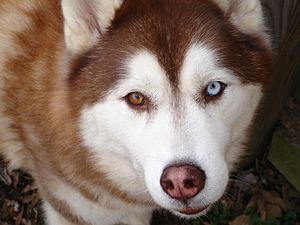
The American Kennel Club describes the Siberian Husky's eyes as "an almond shape, moderately spaced and set slightly obliquely." The AKC breed standard is that eyes may be brown, blue or black; one of each or particoloured are acceptable (complete is heterochromia). These eye-color combinations are considered acceptable by the American Kennel Club. The parti-color does not affect the vision of the dog.
Nose
Show-quality dogs are preferred to have neither pointed nor square noses. The nose is black in gray dogs, tan in black dogs, liver in copper-colored dogs, and may be light tan in white dogs. In some instances, Siberian Huskies can exhibit what is called "snow nose" or "winter nose." This condition is called hypopigmentation in animals. "Snow nose" is acceptable in the show ring.
Tail
Siberian Husky tails are heavily furred; these dogs will often curl up with their tails over their faces and noses in order to provide additional warmth. When curled up to sleep the Siberian Husky will cover its nose for warmth, often referred to as the "Siberian Swirl". The tail should be expressive, held low when the dog is relaxed, and curved upward in a "sickle" shape when excited or interested in something.
Size
The breed standard indicates that the males of the breed are ideally between 20 and 24 inches (51 and 61 cm) tall at the withers and weighing between 45 and 60 pounds (20 and 27 kg). Females are smaller, growing to between 19 to 23 inches (48 to 58 cm) tall at the withers and weighing between 35 to 50 pounds (16 to 23 kg). The people of Nome referred to Siberian Huskies as "Siberian Rats" due to their size of 40–50 lb (18–23 kg), versus the Alaskan Malamute's size of 75–85 lb (34–39 kg).
Behavior
The Husky usually howls instead of barking. They have been described as escape artists, which can include digging under, chewing through, or even jumping over fences.
Because the Siberian Husky had been raised in a family setting by the Chukchi and not left to fend for themselves, they could be trusted with children. The ASPCA classifies the breed as good with children. It also states they exhibit high energy indoors, have special exercise needs, and may be destructive "without proper care".
Siberian Huskies have a high prey drive due to the Chukchi allowing them to roam free in the summer. The dogs hunted in packs and preyed on wild cats, birds, and squirrels, but with training can be trusted with other small animals. They would only return to the Chukchi villages when the snow returned and food became scarce. Their hunting instincts can still be found in the breed today, noted by their typically high prey-drive.
A 6 ft (1.83 m) fence is recommended for this breed as a pet, although some have been known to overcome fences as high as 8 ft (2.44 m). Electric pet fencing may not be effective. They need the frequent companionship of people and other dogs, and their need to feel as part of a pack is very strong.
The character of the Siberian Husky is friendly and gentle. The Husky cannot be used as a guard dog; Siberian Huskies typically have no aggression towards humans. In addition, the breed often shows independence, which is a disadvantage for service dogs. Attempting to teach Siberian Huskies aggressive behavior can lead to mental problems in the dog. It can be dangerous for the owner. The dog is intelligent, but can be stubborn because of its independence, impulsivity and inattention. To achieve obedience it is highly beneficial to start training at an early age.
Siberian Huskies were ranked 77th out of 138 compared breeds for their intelligence by canine psychologist Stanley Coren. However, the rankings in Coren's published work utilized only one of three defined forms of dog intelligence, "Working and Obedience Intelligence", which focused on trainability—a dog's ability to follow direction and commands in a direct context, specifically by trial judges in a controlled course setting. The Siberian Husky's work as a sled dog, with minimal active direction from a driver, and a driver's reliance on the dogs to make their own decisions in poor conditions, utilizes the other two forms, "Instinctive Intelligence" and "Adaptive Intelligence", to a much greater extent.
Health
A 1999 ASPCA publication shows the average life span of the Siberian Husky is 12 to 14 years. Health issues in the breed are mainly genetic, such as seizures and defects of the eye (juvenile cataracts, corneal dystrophy, canine glaucoma and progressive retinal atrophy) and congenital laryngeal paralysis. Hip dysplasia is not often found in this breed; however, as with many medium or larger-sized canines, it can occur. The Orthopedic Foundation for Animals currently has the Siberian Husky ranked 155th out of a possible 160 breeds at risk for hip dysplasia, with only two percent of tested Siberian Huskies showing dysplasia.
Siberian Huskies used for sled racing may also be prone to other ailments, such as gastric disease, bronchitis or bronchopulmonary ailments ("ski asthma"), and gastric erosions or ulcerations.
Modern Siberian Huskies registered in the US are almost entirely the descendants of the 1930 Siberia imports and of Leonhard Seppala’s dogs, particularly Togo. The limited number of registered foundational dogs has led to some discussion about their vulnerability to the founder effect.
History and naming
The Siberian Husky was originally developed by the Chukchi people of the Chukchi Peninsula in eastern Siberia. They were brought to Nome, Alaska in 1908 to serve as working sled dogs, and were eventually developed and used for sled dog racing. In 2015, a DNA study indicated that the Siberian Husky, the Alaskan Malamute and the Alaskan husky share a close genetic relationship between each other and were related to Chukotka sled dogs from Siberia. Siberian Huskies show a genetic affinity with historical East Siberian dogs and ancient Lake Baikal dogs, and can be traced to a lineage which is over 9,500 years old.
From the 1890s to the 1930s, Chukotka sled dogs were actively imported into Alaska, to transport gold miners to the Yukon, first as part of the Klondike Gold Rush. At this time, "Esquimaux" or "Eskimo" was a common pejorative term for native Arctic inhabitants with many dialectal permutations including Uskee, Uskimay and Huskemaw. Thus dogs used by Arctic people were the dogs of the Huskies, the Huskie's dogs, and eventually simply the husky dogs. Canadian and American settlers, not well versed on Russian geography, would distinguish the Chukotka imports by referring to them as Siberian huskies as Chukotka is part of Siberia.
In 1930, exportation of the dogs from Siberia was halted. The same year saw recognition of the Siberian Husky by the American Kennel Club. Nine years later, the breed was first registered in Canada. The United Kennel Club recognized the breed in 1938 as the "Arctic Husky," changing the name to Siberian Husky in 1991. Leonhard Seppala, the foremost breeder of Siberian sled dogs of the time, owned a kennel in Alaska before moving to New England, where he became partners with Elizabeth Ricker. The two co-owned the Poland Springs kennel and began to race and exhibit their dogs all over the Northeast. The kennel was sold to Canadian Harry Wheeler in 1931, following Seppala's return to Alaska.
As the breed was beginning to come to prominence, in 1933 Navy Rear Admiral Richard E. Byrd brought about 50 Siberian Huskies with him on an expedition in which he hoped to journey around the 16,000-mile coast of Antarctica. Many of the dogs were bred and trained at Chinook Kennels in New Hampshire, owned by Eva Seeley. Called Operation Highjump, the historic trek proved the worth of the Siberian Husky due to its compact size and great speed. Siberian Huskies also served in the United States Army's Arctic Search and Rescue Unit of the Air Transport Command during World War II. Their popularity was sustained into the 21st century. They were ranked 16th among American Kennel Club registrants in 2012, rising to 14th place in 2013.
The Sweepstakes race
Smaller, faster and more enduring than the 100- to 120-pound (45- to 54-kg) freighting dogs then in general use, Huskies immediately dominated the Sweepstakes race. Leonhard Seppala participated in competitions from 1909 to the mid-1920s with a number of championships to his name.
1925 serum run to Nome
On February 3, 1925, Gunnar Kaasen was the final musher in the 1925 serum run to Nome to deliver diphtheria serum from Nenana, over 600 miles to Nome. This was a group effort by several sled dog teams and mushers, with the longest (264 miles or 422 km) and most dangerous segment of the run covered by Leonhard Seppala and his sled team lead dog Togo. The event is depicted in the 2019 film Togo. A measure of this is also depicted in the 1995 animated film Balto; the name of Gunnar Kaasen's lead dog in his sled team was Balto, although unlike the real dog, Balto the character was portrayed as a wolf-dog in the film. In honor of this lead dog, a bronze statue was erected at Central Park in New York City. The plaque upon it is inscribed,
Dedicated to the indomitable spirit of the sled dogs that relayed antitoxin six hundred miles over rough ice, across treacherous waters, through Arctic blizzards from Nenana to the relief of stricken Nome in the winter of 1925. Endurance · Fidelity · Intelligence
Siberian huskies gained mass popularity with the story of the "Great Race of Mercy," the 1925 serum run to Nome, featuring Balto and Togo. Although Balto is considered the more famous, being the dog that delivered the serum to Nome after running the final 53-mile leg, it was Togo who made the longest run of the relay, guiding his musher Leonhard Seppala on a 261-mile journey that included crossing the deadly Norton Sound to Golovin, and who ultimately became a foundation dog for the Siberian Husky breed, through his progeny Toto, Molinka, Kingeak, Ammoro, Sepp III, and Togo II.
Interesting facts about Huskies
- Huskies were extensively used as sled dogs by the British Antarctic Survey in Antarctica between 1945 and 1994. A bronze monument to all of BAS's dog teams sits outside its Cambridge headquarters.
- Due to their high popularity combining with their high physical and mental needs, Siberians are abandoned or surrendered to shelters at high rates by new owners who do not research them fully and find themselves unable to care for them.
- Sled dogs that were bred and kept by the Chukchi tribes of Siberia were thought to have gone extinct, but Benedict Allen, writing for Geographical magazine in 2006 after visiting the region, reported their survival. His description of the breeding practiced by the Chukchi mentions selection for obedience, endurance, amiable disposition, and sizing that enabled families to support them without undue difficulty.
- Humans use huskies in sled-dog racing. One can differentiate huskies from other dog types by their fast pulling-style.
- Many huskies, especially Siberian Huskies, are considered “working dogs” and often are high energy.
- Huskies are also kept as pets, and groups work to find new pet homes for retired racing and adventure-trekking dogs.
Suitable activities
Exercise is extremely important for the physical and mental health of these kinds of dogs and it can also prompt a strong bond between the owner and dog. Since many owners now have huskies as pets in settings that are not ideal for sledding, other activities have been found that are good for the dog and fun for the owner.
- Rally Obedience: Owners guide their dogs through a course of difficult exercises side by side. There are typically 10 to 20 signs per course and involve different commands or tricks.
- Agility Training: A fast-paced obstacle course that deals with speed and concentration. Dogs race the clock to complete the course correctly.
- Skijoring is an alternative to sled pulling. The owner would be on skis while the dog would pull via a rope connected between the two.
- Dog hiking is an wonderful alternative for owners who live near or are able to travel to a trail. The owner travels with their dogs along trails in the wilderness. This activity allows the owner and dog to gain exercise without using the huskies' strong sense of pulling. Some companies make hiking equipment especially for dogs in which they may carry their own gear, including water, food, and bowls for each.
- Carting, also known as dryland mushing or sulky driving, is an urban alternative to dog sledding. Here, the dog can pull a cart that contains either supplies or an individual. This is also an acceptable way to use a dog's natural incline to pull in an effective way. These carts can be bought or handmade by the individual.
- Bikejoring is an activity where the owner bikes along with their dog while they are attached to their bike through a harness which keeps both the dog and owner safe. The dog or team of dogs can be attached to a towline to also pull the biker.
See also
 In Spanish: Husky siberiano para niños
In Spanish: Husky siberiano para niños



